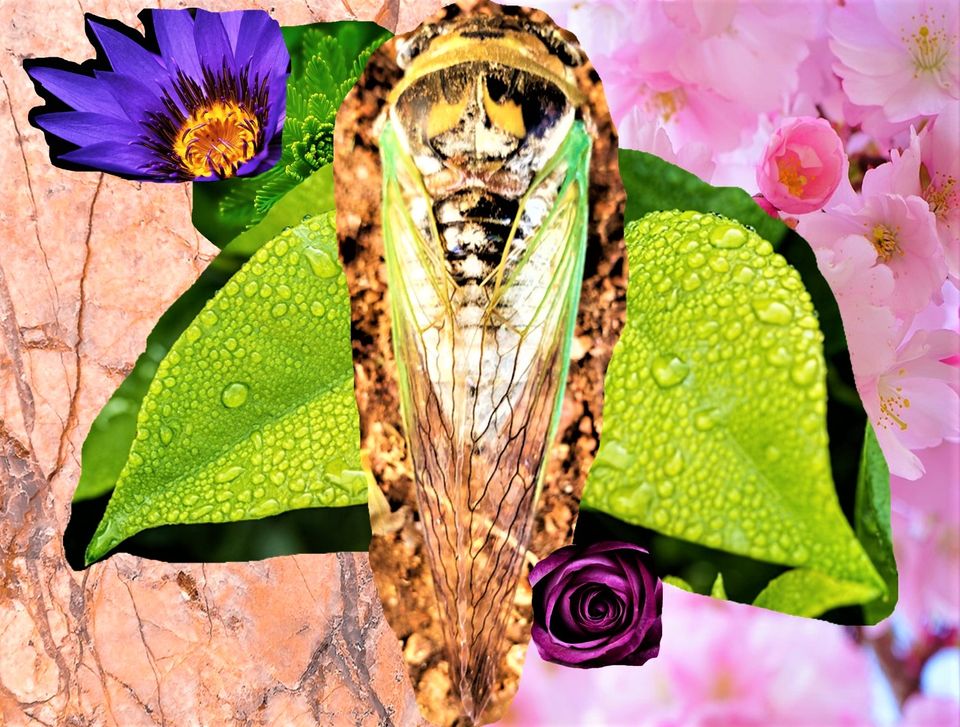The Terrible Beauty of Cicadas

Defiant percussionists assaulting the air, cicadas are a novelty to me, as I don't recall having encountered them as a child. Happily, however, I have recently discovered their seasonal choruses. While enjoying the summer in Payson, Arizona, I noticed them one evening, as the atmosphere suddenly transformed into an auditory stage, a performance venue for things above, thousands of insects I could not see--and did not wish to behold in their multitudes. Really, apart from the overbearing beauty of their song, the presence of cicadas feels a bit pestilential, as it blankets the late afternoon.
From science we learn:
Every year some of the several thousand species of cicada emerge from underground, and the males begin to sing their raucous, almost deafening, song. Among these virtuosos of the insect realm, the males of one species of Australian cicada (Cyclochila australasiae) are distinguished for having the loudest insect call measured so far. (1)
Yes, they are indeed quite loud and intriguing, as well.
Walking in the evening, beneath towering cottonwoods, one hears the variety of tones they emit, like the auditory equivalent of a rough-textured surface, always the same yet different. It's quite amazing. Apparently, I'm not the only one to appreciate the ethereal symphonies of these insects. As indicators of the changing seasons, cicadas have long been known to Chinese and European writers, alike.
( . . .) we find it recognized very early that the different species of cicadas have different periods of emergence. For instance, in the Li Chi the tchen was taken as herald of midsummer and the han-tchen of late autumn. (2)
Moreover, the Cicada has come to represent resurrection in Chinese culture, the shedding of its skin providing a symbol of immortality through rebirth. But there is even more to appreciate about these insects, as their influence reaches deeply into the arts. Plato used their song as a backdrop to the conversation in Phaedrus, encouraging his audience to investigate beyond the surface meaning of words; he wants us to delve further, to fathom the sounds and movements of nature that contextualize the dialogue. (3)
I consider this each day, as the sound descends from canopies of lush trees, pulsating through the humid air. Each interlude begins in the same haunting manner; suddenly, the silence evaporates into an eruption of maracas, a frenzied movement that far exceeds what a human hand could produce. For some reason, I picture thousands of percussion instruments shaking simultaneously as the creatures begin their song. And were it not for the overbearing volume of their music, cicadas would provide a rich backdrop to human life, our conversations unfolding below them. With great curiosity, I continued to gaze each evening at the cottonwoods and wonder about these insects, so musical and outspoken. Then, I saw one.
Horror.
As I have mentioned before, I spent most of my life in Southern California, where robust insects are fairly uncommon. So, I was unprepared for the day I happened upon a burly cicada, with his latticed wings and eyes of complex beauty. It was a revelation; there he was, lifeless on the ground but still quite alarming to this ex-Californian. And here we find a paradox of nature, the terrible beauty of things that fly and creep into the house, insect songs that delight and, at the same time, hint at impending pestilence.
As I walk the dogs in the soft humidity of evening, I still scan the ground for deceased cicadas, and hope to avoid seeing them in flight. As delightful as their summer choruses are, insects are best heard and not seen, in my estimation.
Works Cited:
(1) Henry C. Bennet-Clark. "How Cicadas Make Their Noise" (Scientific American), Vol. 278, No. 5 (May, 1998), pp. 58-61.
(2) Gains Kan-Chih Liu. "Cicadas in Chinese Culture (Including the Silver-fish)" (Osiris, 1950, Vol. 9, P. 290.
(3) G. R. F. Ferrari. "Listening to the Cicadas." A Study of Plato's Phaedrus (Review by C. J. Rowe, The Classical Review, 1988, Vol. 38, No. 2, p. 223.